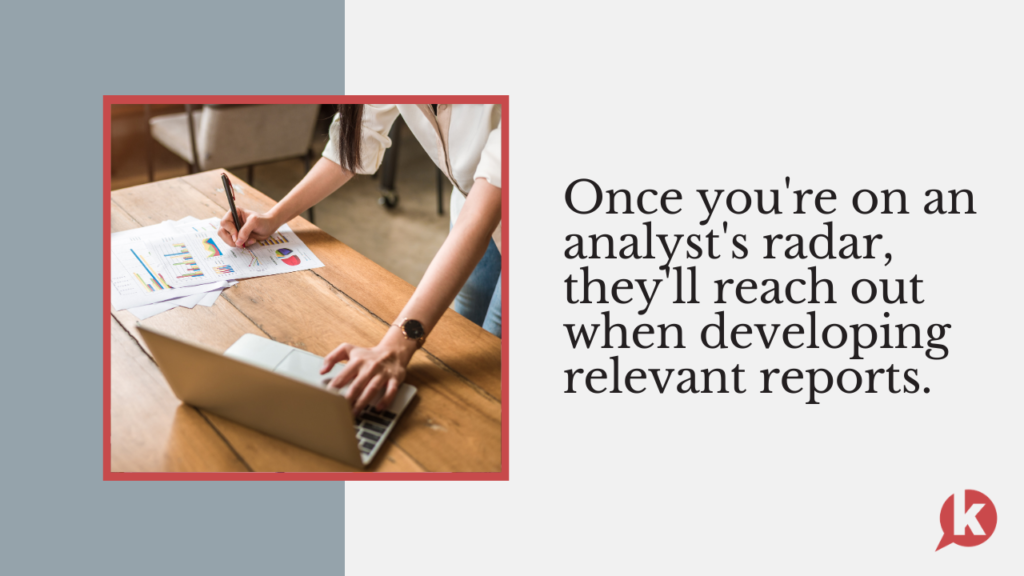Earlier this year, Kirsty laid out the basics of analyst relations for B2B tech companies. Today, we’re going to pick up where she left off and look at Analyst Relations 201.
Analyst briefing basics
The first part of Analyst Relations 201 is the briefing itself. In her blog, Kirsty walked readers through when and why to set up an analyst briefing and how to schedule those calls.
As she mentioned, you might be setting up an analyst briefing ahead of a company or product launch or to provide a company or product overview or update. For the sake of simplicity, we’ll use the company overview briefing for our example today.
First, you’ll want to have the right spokespeople in the briefing. If you’re a startup or smaller company, we recommend this be the CEO and someone from the product team. At a larger tech vendor, you might have a designated product marketer who handles analyst relationships.

Once you have your designated spokespeople identified, it’s time to focus on the content. Usually, we recommend using a sales deck as a starting point. The reason is two-fold:
- It already exists and contains much of the information analysts expect to receive;
- Analysts often provide ad-hoc feedback, so you can easily incorporate their suggested changes into your deck.
In addition to the information you already have in your sales deck, you’ll want to supplement this with details on your company structure, leadership team, go-to-market strategy, and a detailed product roadmap.
Remember, as Kirsty noted, some firms offer 30-minute briefings and others 60-minute briefings, so you’ll want a shorter and longer version of your analyst deck. If you’re looking for more guidance, Gartner offers guidelines, sample agendas and supporting content to help you prepare for briefings.
Analyst report inclusion
The ultimate goal of analyst relations for most vendors is report inclusion. And for reports that provide ranking or ratings — top marks. So how does a vendor get mentioned in one of these reports? Well, first you have to do the aforementioned briefings.
We often encounter prospects and clients who are hesitant to dedicate the time to briefings. But without doing so, you will NOT be included in reports.

Analysts have to know your company exists and what you do before they can write about you. This is also why it’s important that you do as many unpaid (we’ll talk about paid AR in a minute) briefings as the firm allows. You want your company to remain top of mind for each analyst that covers your solution area(s).
Once you’re on an analyst’s radar, they’ll reach out when they’re developing relevant reports. To ensure inclusion, you’ll want to closely manage RFI deadlines, secure customer references and communicate these priorities to your team.
When your company is cited well in a report, you’ll want to license the report to use in your sales and marketing efforts. For major reports, you might even consider doing a press release and distributing the news over the wire.
Paid analyst relationships
When we begin talking about analyst relations with any new prospect, the first thing we often hear is “We can’t afford AR.” Up until now, all of the things we’ve discussed are FREE (beyond the time investment and report licensing fees). But if you are ready to engage in a paid relationship with an analyst firm, there are a few things you’ll want to consider.

First, let’s talk about the benefits. By engaging with analysts on a paid basis, you open up the door for two-way dialogue. This means beyond briefings, you can also schedule inquiries to ask specific questions and receive insight into the market, prospects and competitors.
For Gartner, IDC and Forrester, this comes at a hefty price tag. But if properly managed and resources are dedicated to making the most out of the relationship, you can reap the rewards. Retail-focused firms RSR and IHL offer one-off consulting sessions and IHL also offers hourly “Ask the Analyst” calls.
Additionally, analyst firms like IHL and RSR can also create highly-customized unique research. This research can be used to support your ongoing marketing and sales processes, and drive unique media coverage.
Analyst Relations 201: to infinity and beyond
A robust analyst relations program can take your company to the next level. But you must first dedicate the time to analyst relations. To do so, it can be helpful to bring in an outside partner like Ketner Group. Please reach out and we can discuss how we can help you manage your AR program.
Still unsure about how analyst relations can be beneficial to your business? Join us for May’s KG Connects, “B2B Analyst Relations: The Secret Sauce to Your Communications Program.”

